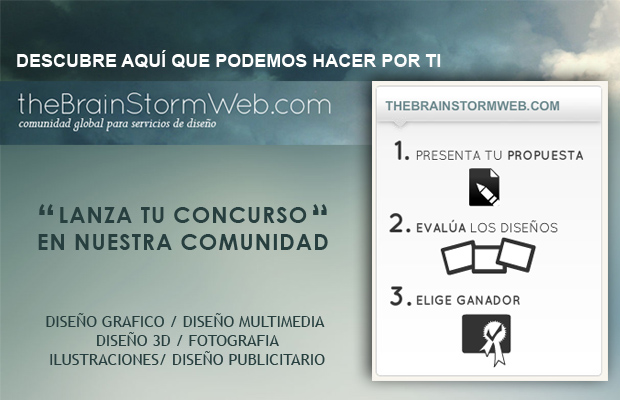Los concursos, ¿un mal negocio? / Contests, are them a bad deal?
Tras el salto un interesante artículo del diseñador gráfico, periodista y editor Álvaro Sobrino, donde explica por qué los concursos son un mal negocio para quienes se presentan y un buen negocio para quienes los convocan.
_______________________________________________________________________
After the jump an interesting article of the graphic designer, journalist and editor Álvaro Sobrino, where he explains why the contests are a bad deal for those who are presented and a good deal for the convenors.
Podrían coleccionarse los argumentos para defender los concursos de diseño: que si son una gran oportunidad para los estudiantes y los diseñadores más jóvenes, que si la dotación (en ocasiones) es mayor que lo que se pagaría a un diseñador si se tratara de un encargo....
Los concursos son un negocio sólo para el que los convoca, a partir del trabajo gratis de los que participan. Las expectativas de ganar son absurdas, a la simple estadística hay que añadir que los jurados son una caja de sorpresas que se rige por argumentos subjetivos cuando no directamente peregrinos, y en los que las variables –los intereses del pagano, la estulticia de algún miembro del jurado que distorsiona la opinión del resto...– pueden llevar el resultado a lugares sorprendentes. Y lo digo con conocimiento de causa, que en algunos he estado.
A la búsqueda de argumentos que avalen estas tesis, creo haber encontrado uno que no he utilizado aún. ¿Cuánto cuesta un concurso de diseño? ¿Quién lo paga?
Me he permitido coger, a modo de ejemplo, el que parece que se está convirtiendo en el concurso estrella en nuestro país: el Francisco Mantecón, que organiza Terras Gaudas. 16000 euros repartidos en tres premios y un accésit, reconozco que está bien dotado.
Quiera el lector imaginar las cuentas por mí en lo restante: convocar y agasajar a un jurado de popes del diseño que se dejan querer (¿cobran por ello?, no lo sé, espero que sí), logística, una comunicación bien planteada, exposición posterior, entrega de premios por todo lo alto... ponga usted la cifra que desee. Hay que reconocer que no escatiman en gasto ni en ruido. Del mismo modo que convendremos en que en ellos recae el beneficio: ni en los diseñadores –más allá de los ganadores– ni en el diseño.
Ahora bien, esos son los costes del organizador. Pero veamos cuales son los costes reales. Este año se han presentado 2100 piezas de 54 países. No consta el dato de cuantas de acá y cuantas del extranjero, en la edición anterior superaron el cincuenta por ciento... démoslo por bueno. Mitad y mitad.
Hay que presentar el cartel sobre soporte rígido en 50x70. Hemos buscado en papelesespeciales.es y cada cartón pluma cuesta cuatro euros.
También hay que adjuntar el archivo en un CD: Cuesta 0,60€ en fnac.es.
Vayamos con el envío. Para los participantes españoles el comparador de precios mensajerialowcost.es nos dice que costará unos diez euros, y 39€ para los extranjeros. saquemos como media 24€ por envío.
Habrá que hacer un plotter, afortunadamente es un coste que ha bajado mucho en los últimos tiempos, en zonaplotter.com cuesta doce euros, plastificado y todo.
Recapitulando:
- Cartón pluma: 4€ por 2100 = 8400€
- Soporte CD: 0.60€ por 2100 = 1260€
- Gastos de mensajería: 24€ por 2100 = 50400€
- Plotter: 12€ por 2100 = 25200€
Lo sumamos todo y nos damos cuenta de que los diseñadores hemos
invertido en unos premios a beneficio de la imagen de una compañía la
friolera de ochenta y cinco mil doscientos sesenta euros (85260€). Sí, catorce millones ciento ochenta y seis mil setenta de las antiguas pesetas.
Por no mencionar el tiempo empleado, podríamos hablar de que si cada aspirante ha dedicado cuatro horas a su cartel, cobradas a precio de empleo-basura, pongamos diez euros la hora, son cuarenta euros por 2100 participantes... pero no, eso sería hacer demagogia.
Por no mencionar el tiempo empleado, podríamos hablar de que si cada aspirante ha dedicado cuatro horas a su cartel, cobradas a precio de empleo-basura, pongamos diez euros la hora, son cuarenta euros por 2100 participantes... pero no, eso sería hacer demagogia.
_______________________________________________________________________
I could collect the arguments to defend the design contest: that if they are a great opportunity for students and young designers, that if the endowment (sometimes) is greater than what a designer would be paid if it were an order ....
Contests are a business only for who convoke them, from the free labor of those involved. The expectations of winning are absurd, the simple statistic must be added that juries are a mixed bag thay is governed by subjective arguments when not directly pilgrims, and in which the variables -the interests of the heathen, the stupidity of some member of the jury that distorts the view of other results...- can lead to amazing places. And I say knowingly, which in some I have been.
In search of arguments in support of this thesis, I believe to have found one that I have not used yet. How much does a design competition? Who pays?
I have allowed to take, by way of example, it seems that the competition is becoming star in our country: Francisco Mantecón, organized by Terras Gaudas. 16000 € spread over three awards and one honorable mention, I recognize that is well endowed.
Now these are the costs of organizing. But let us see what are the real costs. This year habe been presented 2100 pieces from 54 countries. It does not includes the data from here and how many from foreign, in the previous edition they exceeded fifty percent... let them be good. Half and half.
You must present the poster on a rigid support in 50x70. We have search in papelesespeciales.es and each foamboard costs four euros.
We must also attach the file to a CD: It costs 0.60 € in fnac.es.
Let's go with the shipment. For the Spanish participants mensajerialowcost.es price comparison tells us that it cost about ten euros, and 39 € for foreigners. Let's get on average 24 € per shipment.
We must make a plotter, fortunately it is a cost that has plummeted in recent times. It costs twelve euros in zonaplotter.com, with plastic and all.
To recap:
- Foamboard: 4 €x 2100 = 8400 €
- CD support: 0.60 € by 2100 = 1260 €
- Messaging expenses: 24 € x 2100 = 50,400 €
- Plotter: 12 € x 2100 = 25,200 €
Not mentioned the time spent, we could talk about that if each candidate has spent four hours at his poster, use price charged to junk, say ten euros an hour, is forty euros by 2100 participants... but that would be to make demagoguery.


Comentarios
Publicar un comentario
Escribe aquí tu comentario.